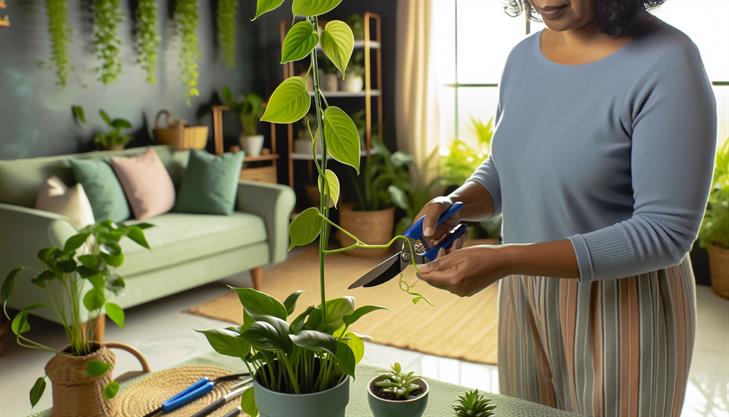If you’re the proud owner of a thriving pothos plant, you’ve likely marveled at its ability to transform any space with lush, trailing vines. But with that growth comes a gardener’s dilemma: how far should you trim your tropical companion to keep it healthy and vibrant? Whether you’re a seasoned plant parent or a budding enthusiast, knowing the art and science behind trimming a pothos is crucial. Proper pruning not only enhances the plant’s aesthetic appeal but also encourages fuller, more vigorous growth. This guide is your blueprint to mastering the pothos trim—balancing between maintaining an Instagram-worthy plant and ensuring its long-term health. Read on to unlock the secrets of expert trimming strategies that will breathe new life into your beloved green friend.
Understanding When and Why to Trim Your Pothos
Trimming your Pothos plant is a key aspect of plant maintenance that helps promote healthy growth and manage its shape and size. Knowing how far to trim a Pothos plant can be a little daunting if you’re new to plant care, but with the right guidance, it’s a straightforward process. Let’s explore the best practices for trimming your Pothos plant effectively.
Why Trim Your Pothos?
Trimming, or pruning, a Pothos plant is essential for several reasons. First, it encourages bushier growth as cutting back lengthy vines stimulates the plant to fill out. Additionally, regular pruning helps control the size of your Pothos, preventing it from becoming too unwieldy. Furthermore, removing yellow or dead leaves prevents any potential spread of disease and keeps your plant looking vibrant.
When to Trim Your Pothos
It’s generally best to trim your Pothos during its active growing season, which is in spring and summer. However, sparse trimming can be done all year round if necessary, especially to remove any dead or damaged leaves or stems.
How Far to Trim Pothos Plant
Here’s a step-by-step guide on how to trim your Pothos:
-
Gather Your Tools: Start with a clean, sharp pair of scissors or pruning shears to ensure a clean cut without damaging the plant.
-
Examine the Plant: Look for stems that are particularly long, leggy, or have a lot of space between leaves. You’ll also want to identify any yellow or brown leaves, as these should be removed.
-
Decide How Much to Trim: You can safely trim back up to one-third of your Pothos at a time. If you are looking to reduce overall size significantly, it’s best to do this gradually over several weeks. For regular maintenance, trimming back to just above a leaf node (the point where leaves emerge from the vine) is usually all that’s needed.
-
Make the Cut: When you cut, make sure to do so just above a leaf node, as this is where new growth will sprout. For damaged or unhealthy leaves, trim as close to the stem as possible.
-
Encourage Regrowth: After trimming, place your Pothos in a location with bright, indirect light to encourage its recovery and regrowth.
Common Issues and Tips
-
Yellow and Brown Leaves: If a large portion of your Pothos has yellow or brown leaves, check for overwatering, low humidity, or lack of nutrients, as trimming alone won’t solve these underlying issues.
-
Leggy Growth: Excessively long vines with few leaves indicate that your Pothos might not be getting enough light. Move it to a brighter spot after trimming to encourage more compact growth.
-
Use Cuttings for Propagation: Don’t discard healthy cuttings; instead, use them to propagate new plants. Place them in water or soil after trimming, ensuring at least one node is submerged in water or buried in soil to encourage root growth.
By following these steps, you can successfully trim your Pothos plant, maintaining its health and aesthetic appeal. Regular pruning tailored to your plant’s growth needs will ensure a thriving and lush Pothos that enhances your living space.
Step-by-Step Guide to Trimming Pothos Plants
Trimming a pothos plant is an essential part of care that encourages healthy growth, enhances its shape, and prevents it from becoming leggy. Understanding how far to trim a pothos plant can significantly impact its health and appearance. Here’s a step-by-step guide to help you:
Step 1: Gather the Necessary Tools
Before you start trimming, ensure you have the right tools ready. You’ll need:
- Sharp scissors or pruning shears: These should be clean to prevent any disease transmission.
- A clean cloth or tissue: To blot any sap that may escape as you trim.
Step 2: Assess the Plant
Take a close look at your pothos:
- Identify any brown or yellow leaves: These should be removed as they indicate old or unhealthy parts of the plant.
- Find vines that are excessively long or leggy: These can be trimmed back to promote bushier growth.
Step 3: Decide How Much to Trim
When considering how far you should trim your pothos, it’s crucial to determine your goals:
- For Light Maintenance: Just trim the tips back by a couple of inches to maintain your plant’s current shape.
- For Promoting Growth: Cut back lengthy vines by one-third or more. While you can trim more aggressively, ensure not to remove more than two-thirds of a single vine at once.
- For Reshaping: Trim vines back to their base or to a point where you want new growth, always leaving at least one or two leaves on each vine to encourage regrowth.
Step 4: Make Precise Cuts
- Cut just above a leaf node (a small bump where leaves grow) or at a vine junction to encourage new shoots.
- Ensure each cut is clean to protect the plant from potential infections.
Step 5: Clean Up
- Remove any fallen leaves or vine scraps immediately.
- Wipe down your tools to keep them clean for future use.
Common Issues and Additional Tips
- Over-Trimming: Trimming too much can stress the plant, so avoid removing more than half of the foliage at once.
- Monitor for Disease: Regularly check for signs of disease or pests, especially after trimming. If you spot issues, treat them promptly.
- Consider Propagation: Use the healthy cuttings to propagate new pothos plants. Simply place them in water until roots develop, offering a sustainable way to increase your indoor greenery.
By following this guide, you’ll ensure your pothos remains lush, vibrant, and well-maintained. Understanding how far to trim your pothos plant helps in managing both its appearance and its health, ensuring that it thrives in your home.
Best Tools for Trimming Pothos for Best Results
Trimming a pothos plant is an essential part of its care, promoting healthy growth and maintaining a bushy appearance. Understanding how far to trim a pothos plant can optimize its development and enhance its overall aesthetic. Here’s a step-by-step guide to ensure you’re trimming your pothos correctly, along with additional tips and common pitfalls to avoid.
1. Gather the Right Tools:
Before diving into how far to trim your pothos plant, ensure you have the proper tools on hand. You’ll need sharp pruning shears or scissors that are clean and disinfected to prevent the spread of diseases. A small container or bag for collecting cuttings is also helpful.
2. Assess Your Pothos:
Look at your plant’s current state to identify overgrown sections, leggy stems, or any dead or yellowing leaves that need removal. This will give you a clearer idea of where and how far you need to trim.
3. Determine Trimming Length:
A general rule-of-thumb for trimming a pothos is to cut back up to 1/4 of the plant at one time. If your pothos has long, trailing vines, trim them to the desired length, typically just above a leaf node. Trimming above a node encourages new growth, as these nodes are where new roots and leaves can form. Remember, you can always trim more later, but you can’t undo a cut.
4. Trim Strategically:
Begin by trimming back dead or damaged leaves and stems. For shaping, cut just above a leaf node to encourage bushiness and fuller growth. Keep in mind that each cut can stimulate the plant to branch out, creating a more lush appearance.
5. Managing Overgrown Pothos:
If your pothos has become too woody or sparse, don’t hesitate to trim a bit more aggressively. Cutting a stem back to half its length can rejuvenate and reinvigorate the plant, promoting new, healthy growth.
6. Watch for New Growth:
After trimming, monitor the pothos for new growth. With proper light and water, you should see new leaves sprouting from the nodes you’ve cut.
Additional Tips:
- Timing: The best time to trim a pothos is during its active growing season, typically in spring or summer. This gives the plant ample time to recover and grow.
- Propagation Opportunity: Use the trimmed cuttings for propagation. Place them in water or soil to grow new pothos plants.
- Lighting Considerations: Ensure your pothos is getting adequate light after trimming to fuel its recovery and growth. Bright, indirect light is ideal.
- Consistent Care: Beyond trimming, regularly check the plant for signs of stress or illness, such as wilting or discoloration, to maintain its health.
Common Issues:
- Over-trimming Risk: Cutting too much at once can stress the plant. Always leave sufficient foliage to allow for photosynthesis.
- Dull Tools: Using non-sharp or dirty tools can damage the plant, creating jagged cuts that are prone to disease.
- Ignoring Light Needs: Not compensating for the plant’s lighting needs post-trim can hinder its recovery process.
Understanding how far to trim a pothos plant not only enhances its health and appearance but also enriches your overall experience as a plant caretaker. By following these guidelines, you’ll ensure your pothos continues to thrive and enliven your space.
Tips for Encouraging Healthy Growth After Trimming
Properly trimming your pothos plant can encourage healthy growth and maintain its lush appearance. Understanding how far to trim a pothos plant is essential for promoting robust growth and preventing any undue stress on the plant. Here’s a detailed guide to help you trim your pothos effectively:
Understanding the Basics of Trimming a Pothos Plant
Pothos plants are resilient and relatively simple to care for, making them perfect for indoor spaces. However, like all houseplants, they benefit from regular pruning to keep them looking vibrant and healthy. Pruning encourages bushier growth, prevents legginess, and helps manage the plant’s size.
How Far to Trim a Pothos Plant
-
Start with the Right Tools: Use sharp, clean scissors or pruning shears to prevent disease transmission. Sanitizing your tools with rubbing alcohol before and after use is a good practice.
-
Identify Overgrown or Unruly Vines: Look for long, leggy vines with sparse leaf growth or unhealthy stems. These are prime candidates for trimming.
-
Trim Strategically at the Nodes: Nodes are the brownish bumps on the vine where leaves emerge. Always prune just above a node, as this encourages new growth from that point. You can comfortably trim back each vine by a third, which is a safe amount for light pruning.
-
Target Around 2-3 Inches Above the Soil for New Growth: This area is ideal when you want to rejuvenate the plant’s appearance significantly. It allows energy to focus on new, healthy shoots.
Encouraging Healthy Regrowth
-
Promote Even Growth: Trim evenly around all sides to encourage the pothos to grow uniformly, preventing a lop-sided appearance.
-
Minimize the Stress: Avoid cutting more than a third of the plant at once to reduce stress. Severe cutting might shock the plant, slowing down regrowth.
-
Provide Optimal Conditions: Ensure that the plant is in bright, indirect sunlight and is watered appropriately. Avoid overwatering, as this can lead to root rot. Allow the soil to dry out slightly between waterings.
-
Fertilize Wisely: After trimming, a balanced, water-soluble fertilizer can help promote new, vigorous growth. Use it sparingly every 4-6 weeks during the growing season.
Common Issues and Troubleshooting
-
Leaf Browning or Yellowing: This can occur if the plant is trimmed excessively or when it’s not watered properly. Monitor and adjust care routines as needed.
-
Slow Growth Post-Trimming: Diseased or unhealthy plants might struggle post-trimming. Check for root health and signs of pests or diseases.
-
Encouraging Bushiness: If your pothos is not filling out well, consider pruning more frequently but with less intensity each time to encourage side growth.
Additional Advice
-
Timing Your Trim: The best time to trim a pothos is during its growing season—spring and summer. The plant’s natural energy will support better regeneration during these times.
-
Prune Regularly: Regular trimming sessions can prevent the need for drastic measures later and keep the overall appearance neat.
Following these guidelines on how far to trim a pothos plant will help ensure your plant thrives and continues to be an attractive addition to your home. Consistent care and mindful trimming can make all the difference in encouraging a healthy, full pothos.
Troubleshooting Common Trimming Issues & Solutions
Trimming a pothos plant, also known as Devil’s Ivy, not only helps maintain its shape but also encourages healthy growth and fullness. Knowing how far to trim a pothos plant is essential for promoting continuous lush foliage and preventing leggy vines. Here’s a comprehensive guide to help you expertly trim your pothos plant.
Understanding When and How Far to Trim Pothos
1. Recognizing Signs for Trimming:
- Overgrowth: If your pothos has grown too long and is losing its shape, it might be time for a trim.
- Leggy Vines: Sparse leaves on long vines suggest that the plant could benefit from pruning.
- Brown or Yellow Leaves: These are usually indicators that those sections should be trimmed to promote overall plant health.
2. How Far Should You Trim?
- New Growth Encouragement: For encouraging bushier growth, trim just above a node (the spot where leaves and roots grow from the vine). Doing so will stimulate the plant to sprout new shoots from that point.
- Routine Maintenance: For regular upkeep, remove up to one-third of the vine’s length. This keeps the plant manageable and prevents stress.
- Dead or Damaged Parts: Always remove dead or significantly damaged leaves and sections. Trim these as close to the main stem as possible without harming it.
Step-by-Step Trimming Instructions
Gather Your Tools:
- Clean, Sharp Scissors or Pruning Shears: Ensure your tools are disinfected to prevent the spread of disease.
Trimming Procedure:
-
Identify the Nodes: Before cutting, locate the nodes on your pothos. They look like small bumps on the vine and are crucial for new growth.
-
Start with Damaged Areas: Trim any brown, yellow, or dead leaves first. Use your shears to make clean cuts close to the main vine.
-
Trim for Growth: Decide how far you want the overall vine to go. If maintaining a certain length, cut just above a node to encourage new branches to sprout.
-
Create Shape: If the plant is too bushy on one side, trim those vines to promote even growth.
Post-Trimming Care:
- Watering: After trimming, ensure the pothos receives adequate water to help it recover. However, be cautious not to overwater.
- Placement: Return the plant to its ideal spot, preferably where it receives indirect sunlight and ample airflow.
Troubleshooting Common Trimming Issues
1. Overpruning:
Trimming too much can stress the plant. If you accidentally cut more than one-third of the plant, allow extra recovery time with regular care and proper sunlight.
2. Unwanted Growth Directions:
Sometimes new growth doesn’t sprout where desired. To correct, gently train new shoots by redirecting them as they grow. You can use stakes or hooks if needed.
3. No New Growth:
Ensure that the plant is in ideal conditions (light, water, and nutrients). If new growth doesn’t appear, verify that adequate nodes remain.
4. Handling Multiple Types:
If you have multiple pothos varieties (e.g., Golden, Marble Queen), note their specific requirements. While trimming techniques are similar, growth rates may vary, influencing how often you trim.
By following these guidelines, you will effectively manage how far to trim a pothos plant, promoting healthier and more aesthetically pleasing growth. These steps not only help maintain your plant’s appearance but also significantly boost its longevity.
In conclusion, trimming your Pothos plant is an essential practice that not only enhances its appearance but also promotes healthy growth. By understanding how far to trim, typically by cutting just above a node to encourage new leaf growth, you can help your Pothos thrive and maintain its lush, vibrant look. It’s important to consider factors such as the plant’s size, overall health, and desired shape when deciding how much to trim. Remember to use clean, sharp scissors to make clean cuts and avoid damage.
Now that you have a blueprint for trimming your Pothos, it’s time to put this knowledge into action. Regular maintenance will ensure your plant remains a beautiful and engaging part of your indoor greenery.
As a final tip, consider repurposing the trimmed cuttings to propagate new Pothos plants. Place them in water or soil and watch them grow, extending the life and beauty of your original plant while creating the opportunity to share your new plant with friends or expand your collection. Happy gardening!


